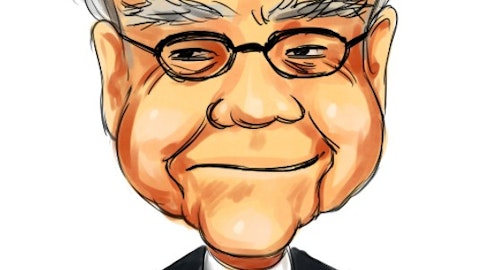Wal-Mart Stores, Inc. (NYSE:WMT) generated revenues of $484 billion over the last 12 months.
If Wal-Mart were a country (assuming revenue is about equal to GDP), it would be the 28th largest in the world.
Compare Wal-Mart’s 12 month sales totals to its peers:
– Wal-Mart sales of $484 billion
– Target Corporation (NYSE:TGT) sales of $74 billion
– Costco Wholesale Corporation (NASDAQ:COST) sales of $117 billion
– Amazon.com, Inc. (NASDAQ:AMZN) sales of $101 billion
Wal-Mart generates 165% of the sales of Target, Costco, and Amazon combined.
Not only does Wal-Mart have more revenues than these 3 companies combined, it also has the highest profit margin.
Target, Costco, and Amazon have a collective market cap of $408 billion (around $300 billion just for Amazon), whereas Wal-Mart has a market cap of $206 billion.

Wal-Mart is one of the most popular retailers among institutional investors. Out of some 730 funds tracked by Insider Monkey, 61 reported long positions in the company as of the end of the third quarter, having amassed stakes with a total value of $7.09 billion, which represented some 3.40% of the company. However, between July and September, the stock lost some popularity, since at the end of June, 65 funds held around $8.52 billion worth of the company’s shares. Billionaire Warren Buffett’s Berkshire Hathaway is one of the largest shareholders of Wal-Mart, holding some 55.19 million shares, according to its last 13F filing.
Current Events – The Bad and the Good
The reason Wal-Mart is so much cheaper than its peers is because the company is anticipating declining earnings-per-share for 2 years.
This decline is due to the company raising the salaries of its employees – likely in an attempt to reduce employee turnover and stem the backlash against the company’s infamous low wages.
Wal-Mart is also investing heavily in digital sales – which are not yet profitable. This is causing a drag on company earnings. As digital sales scale, they will become profitable and supplement Wal-Mart’s profits from its physical stores.
Negative news has caused Wal-Mart’s stock price to decline by 24% over the last 12 months.
Not all news surround Wal-Mart is bad.
The company’s share price is recovering from lows. Wal-Mart stock is up over 12% in the last quarter – while the S&P 500 is down 8% over the same time period.
The company’s latest (3rd quarter) earnings release was generally positive.
Constant currency revenue grew 2.8% for the company.
Comparable store sales in United States Wal-Mart stores grew 1.5%, the 5th consecutive quarter of increases.
As mentioned above, rising wages and heavier digital investment caused operating income to decline 8.8% versus the same quarter.
Wages will not continue to rise at such a rapid clip. The company’s margins will stabilize and recover, while improvements will likely cause revenue (and eventually earnings) to increase as well.
Wal-Mart’s Competitive Advantage
Wal-Mart’s competitive advantage is its “Everyday Low Prices” strategy.
Wal-Mart is the largest retailer in the world. It commands the best prices from its suppliers. The company pressures suppliers to lower their prices and then passes savings on to consumers which results in a positive feedback loop.
Wal-Mart’s efficient supply chain helps the company save money on transportation. The core philosophy of Wal-Mart is to give customers the best deals possible. That is what the company is based on, and that is how Wal-Mart has grown to be so successful.
Wal-Mart’s competitive advantage is very easy to grasp. The company’s business model is very simple. Warren Buffett is an advocate of easy-to-understand businesses with strong competitive advantages. Perhaps that’s why Wal-Mart is one of Warren Buffett’s largest holdings.
Follow Walmart Inc. (NYSE:WMT)
Follow Walmart Inc. (NYSE:WMT)
Receive real-time insider trading and news alerts
Wal-Mart’s Growth Prospects & Expected Total Return
The job of management is to maximize long-term shareholder value.
Sometimes investing to maximize long-term gains can lead to short-term declines.
Wal-Mart’s management should be applauded for taking a long-term view and restructuring the business now instead of waiting.
Wal-Mart is investing in its:
– Employees
– Supply Chain
– Digital Capabilities
By April of 2016, all employees will earn $10 or more per hour. Wal-Mart is already seeing an increase in applications. Higher demand for Wal-Mart jobs will likely translate into less turnover, which will save the company money in the long-run.
In addition to wage raises, Wal-Mart is also investing in longer training time for its employees to provide better service for customers.
Infrastructure investments hurt short-term profits, but will strengthen the company’s price-based competitive advantage in the long-run. Wal-Mart’s investments in infrastructure will speed delivery to stores, reducing loss from expired items and perishables.
Wal-Mart Labs is the company’s tech hub. Wal-Mart Labs is based in San Bruno, California; not in Bentonville, Arkansas. The separate location shows Wal-Mart Labs autonomy from the corporate office.
Wal-Mart Labs handles the data science for Wal-Mart. The company is rapidly growing its digital sales. Wal-Mart now generates $12 billion in digital sales… And sales are growing at 17% annually.
The company is expecting revenue growth of between $45 and $60 billion over the next three years which comes to 3% to 4% a year.
Wal-Mart will also repurchase $20 billion in shares over the next 2 years. This is about 10% of the company’s market cap at current price.
Large share repurchases will partially offset Wal-Mart’s margin declines due to employee salary raises and digital investments. Margins are expected to fall over the next 2 years before normalizing and improving as digital sales scale.
Share repurchases should normalize at around 2% to 3% of shares outstanding a year over the long run.
Over the long-run, Wal-Mart shareholders should expect total returns of between 8% and 11% a year from:
– Dividend yield of 3%
– Revenue growth of 3% to 4% a year
– Share repurchases of 2% to 3% a year
– Margin improvements of 0% to 1% a year
Wal-Mart’s Stellar Recession Performance
Wal-Mart Stores, Inc. (NYSE:WMT) performed exceptionally well during the Great Recession of 2007 to 2009. The company’s earnings-per-share each year through this difficult time are shown below:
– 2007 earnings-per-share of $3.16
– 2008 earnings-per-share of $3.42
– 2009 earnings-per-share of $3.66
For comparison, the S&P 500’s earnings-per-share over the same period are shown below:
– 2007 earnings-per-share of $75.20
– 2008 earnings-per-share of $16.89
– 2009 earnings-per-share of $56.33
As you can see, Wal-Mart rolled through the Great Recession as if it didn’t even happen. The average business in the S&P 500 suffered significant earnings declines.
The reason Wal-Mart did so well during the Great Recession is its reputation for low prices. When hard times set in, consumers stretch their dollars farther. Wal-Mart has a reputation for selling merchandise at ‘everyday low prices’.
In 2008, The S&P 500 fell 37.0%… Wal-Mart stock gained 21.6% due to higher earnings and an influx of investors fleeing to one of the only businesses that was still thriving.
The company’s business model makes Wal-Mart an ideal recession stock for investors.
Valuation and Final Thoughts
Wal-Mart is currently trading for an adjusted P/E ratio of just 13.7.
The company’s P/E ratio has averaged around 15.0 over the last decade.
In addition, Wal-Mart’s stock are trading near all time dividend yield highs.

Based on its historical dividend yield and price-to-earnings ratio, fair value for Wal-Mart shares is likely around $80.
The stock is currently trading for ~$65 per share, implying ~23% upside from current prices.
Wal-Mart Stores, Inc. (NYSE:WMT) ranks in the Top 10 using The 8 Rules of Dividend Investing due to the following metrics:
– Above average 3% dividend yield
– Conservative ~40% payout ratio
– Low price-to-earnings ratio of 13.7
– Market beating expected total returns 8% to 11% a year
– Low 10 year stock price standard deviation of 19.5%
– Low 10 year Beta of 0.5
Wal-Mart’s stock price declines over the last year combined with the higher-than-average possibility of a recession in 2016 make now an excellent time to buy into this industry leading corporation.
Disclosure: None




